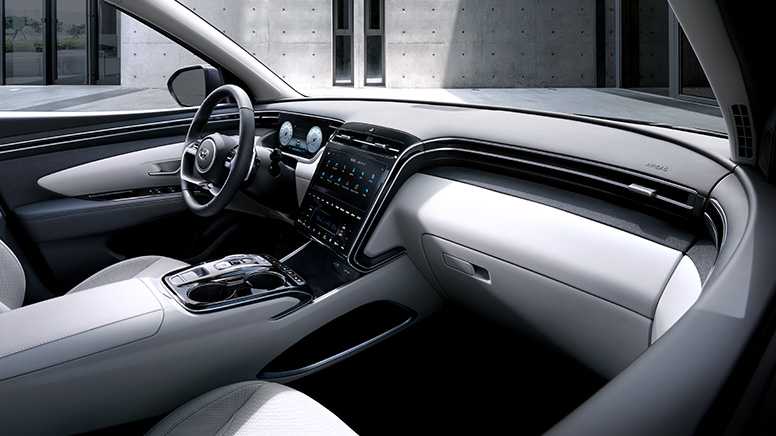Tucson is back. And based on its features, such as innovative design and various advanced features, the new Tucson definitely leads the segment. Among them, here are three new elements of the air conditioning system that provide fresh air while in the car.
Hyundai Motor Company has unveiled its 4th-generation Tucson. Everything has changed, including innovative design, new eco-friendly powertrain, and various advanced safety and convenience features. The most notable change, however, is the new air conditioning system. It features new technologies such as After Blow, Multi Air Mode, and the In-cabin PM Meter. Here is Tucson’s special air conditioning system that creates an ever-refreshing in-cabin environment.
Real-time Air Quality Monitor, Purifier

Rising concerns over in-cabin air quality are have affected automakers as air pollution seems to have various malign health effects. The cabin is not completely airtight; passengers are not free from fine dust or germs in the air. Even though you activate the recirculation mode, it is impossible to get completely secluded from the outside.
However, there is no need to worry about fine dust inside the new Tucson, thanks to the additional fine dust management system called ‘Fine Dust Indicator’. The fine dust management system identifies the air inside the cabin in real-time and measures the concentration of fine dust to display the status. Based on the PM2.5-threshold set by the Ministry of Environment of South Korea, the system notifies the information intuitively by displaying the concentration and pollution levels of fine dust with four colors. Fine dust concentration levels are marked from 0 to 199, blue for 0 to 15 μg/m³, green for 16 to 35 μg/m³, orange for 36 to 75 μg/m³, and red for 76 μg/m³ or higher.

If the level of ultrafine particles exceeds 36 μg/m³ while the function is active, the air-cleaning mode will run to purify the air in the vehicle. The air-cleaning system automatically sets the air volume between 3 and 8 and automatically switches to the recirculation mode and activates the air conditioning system to reduce in-cabin humidity.
In addition, the air conditioner is operated to prevent problems such as interior window condensation and temperature rise caused by increased in-cabin humidity that we created – carbon dioxide and body temperature. In addition, if the engine is off with the Clean Air button pressed, the air purifier will get automatically activated unless you restart the engine after seven days.
Pleasant Soft Wind: Multi-Air Mode Technology

You may have felt uneasy at least once due to the strong wind coming from the air conditioning. This is because the winds directly touch the skin. Unfortunately, it is hard to adjust the wind volume as weak as you want, and no matter how you change the direction, the wind would still bother you. Hyundai has applied ‘Multi-Air Mode technology’ to Tucson for the first time to improve such inconvenience. Instead of changing the existing air vents, the automaker applied additional multi-air slots that send wind subtly throughout the dashboard to disperse the wind.
Using the Multi-air Mode is simple and easy. When this mode is activated, the air is dispersed to the newly added multi-air slots in the driver and passenger seats in addition to the normal air vents. The overall wind volume remains the same, but the dispersion of wind reduces direct air contact and softens the air – just like wind-free air conditioners do.
After-Blow Technology To Remove Odor From The Air Conditioner

Despite the hot weather in summer, sometimes you are afraid to turn on the AC. It’s because of the unpleasant smell that comes from the air conditioner. If changing filters doesn’t work, the source of the odor will be somewhere else – the evaporator, which is an essential part of the air conditioning system. The evaporator is a device that lowers the temperature by using the principle of absorbing the heat around the liquid when it evaporates, creating a cold wind for the air conditioner. However, the problem is that water drops (condensate) form on the surface of the cold evaporator due to the temperature difference from the surrounding area, and molds grow over time. After-Blow is a technology that keeps the evaporator clean by preventing mold growth by drying it with the wind.

Hyundai has found a way to solve the problem; after the engine is turned off and the condensate on the evaporator drains naturally for about 30 minutes, ‘After-Blow’ activates for 10 minutes to dry the evaporator and any condensate leftover in the air passage. The air-conditioning system automatically allows the influx of outside air during this time to prevent humidity from building up. The technology uses an intelligent battery sensor (IBS) to monitor the battery and stops functioning when the battery is low, allaying any concerns about battery discharge. It also de-activates when the air conditioning system is not in use for a certain period of time, or when the outside temperature is low.

Apparently, the new Tucson is perfected with such high-tech features for passengers: After-Blow, Multi-Air Mode, and Fine Dust Indicator newly applied to the air conditioning systems for a pleasant in-cabin climate. From the evaporator hidden inside the car to the air vents – the final stage of the air conditioning system – the automaker created everything from the very beginning and did not miss anything: hygiene, air quality, and convenience inside the vehicle. Here is Hyundai Tucson’s new air conditioning technology ‘Quality Air,’ which protects passengers’ health as well as comfort through the delicate air management system.
